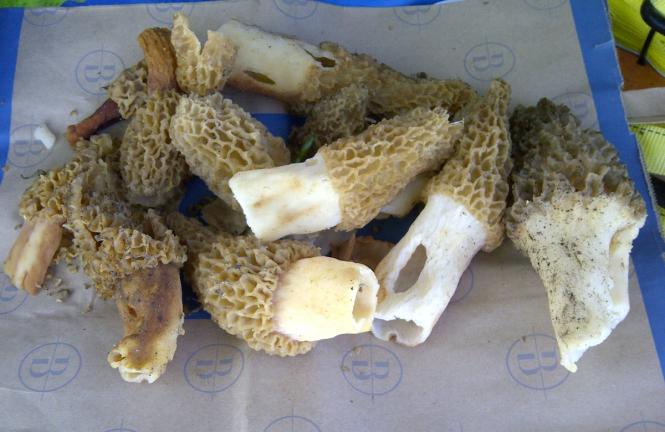Spring is finally here, and along with it comes a whole new hunting season. I’m not referring to the spring turkey season; I’m talking about the spring foraging season. As the woods and prairies come alive with new growth, a plethora of wild edibles come into season. From May until the first snow falls, there are literally thousands of wild plants that grow in the wild. And these plants, berries, and mushrooms are as delicious – if not more delicious – than anything you can buy in the grocery store. I love getting out into the woods and finding wild foods that I can take home, not just because of their distinctive flavors but also because foraging is a great way for me to stay connected with nature and to scout possible hunting areas for the upcoming fall hunting season.
Most people have been out in the woods and found wild berries of some sort and eaten them right off the vine. As a kid, I would go out into the woods behind my grandmother’s house and fill old cool whip containers full of black raspberries. I always used to feel a sense of accomplishment when I would bring them back to my grandmother. I still get that same feeling when I bring home a big bag of ramps or nettles. Going out and finding wild foods and turning them into delectable meals is one of the highlights of my spring. You can find certain wild plants such as ramps and morels at markets near you, but chances are you will pay a premium price for them. With a little bit of research and some free time, it is very easy to identify certain foods and start foraging for some of your meals. You don’t have to go far. Within 15 minutes of my house, I can find morels, ramps, and nettles, and within a few hundred yards of my house there are gooseberries and cattails and dandelions everywhere. All of these plants are edible and can be tasty if picked at the right time.
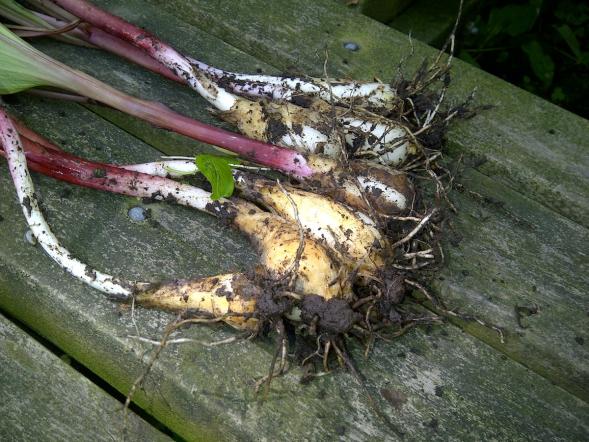 Freshly foraged ramps
Freshly foraged ramps
I have been out foraging for many years, and I have only picked and eaten a small fraction of what is available out there. There are entire books dedicated to the different types of mushrooms that you can find out in the woods and even more field guides to all of the different wild plants. For this post I decided to focus on three of my favorite plants to forage.
One of the first plants to start pushing up through the ground are stinging nettles, which can be found along roadsides and tree lines and pretty much anywhere near pastures and streams. Most of us learned what these are at a very early age, and also learned not to go near them. Anyone who has come into contact with stinging nettles can tell you that the unpleasant burn and itch that comes with them is enough to make you never go near them again. So why on earth would anyone want to eat them if they cause such irritation on the outside of the body? The answer is simple: when prepared correctly, they are delicious. However, the first time I ate nettles, I was not impressed; they were prepared very simply, just sautéed with a little garlic and butter, and I remember my first thought was that if green had a flavor it would taste like nettles. To me, they tasted like really strong wilted spinach with a scoop of dirt added for flavor. It wasn’t a hit as far as I was concerned.
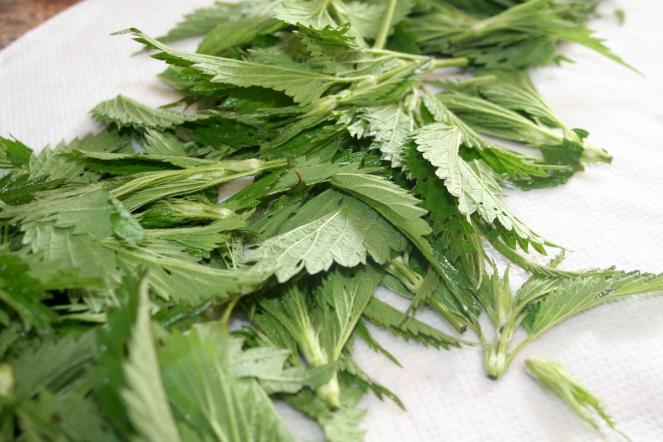 Stinging nettles
Stinging nettles
The first time I made nettles myself, I followed a recipe by a Swedish chef named Andreas Viestad; his method was much more pleasing to me – a nettle soup with vegetable stock and heavy cream. The cream help mellow out the nettles and made them much more palatable. The real kicker to the soup was the addition of smoked trout; the trout added a beautiful smoky, salty quality that really harmonized the entire dish. At that point, I was absolutely convinced that nettles could and would be a part of my regular menu. A friend of mine named Rick Edwards convinced me of that even further when he introduced me to nettle beer. Rick had made several batches and it was fantastic, not just as a cool drink but also as a marinade for meat. Beef heart marinated in nettle beer with some onions and garlic is one of the best things I have ever eaten. The other thing Rick introduced me to was nettle salt, which he made by drying the leaves and crushing them, then mixing them with regular kosher salt. It’s a beautiful, earthy salt that adds a great amount of flavor when grilling.
Spring also brings with it one of everybody’s favorite mushrooms, the morel, which are usually found in moist wooded areas and burned fields. Morels usually start popping up in Minnesota in early May and continue to grow for a few weeks and then – just as mysteriously as they arrived – they all but disappear for another year. Morels are one of the easiest mushrooms to identify, but they are some of the hardest to find. Their color and shape blend into the forest floor and because they grow under dead leaves and trees, they are sometimes very sporting to find. The first few years I went looking for morels, I didn’t find a single one, but when I did finally find my first morel, it was like someone had lifted a curtain and I could suddenly see them everywhere.
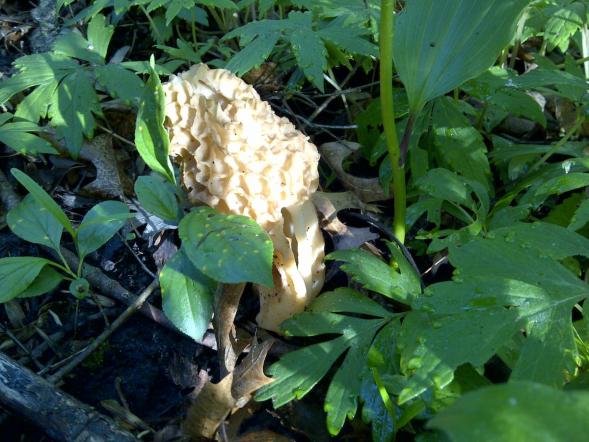 A morel in the wild
A morel in the wild
Morels are prized for their flavor and everybody who has ever looked for them has a favorite recipe. To be perfectly honest, morels are probably my second or third favorite mushroom. Chanterelles and sulfur shelf mushrooms like chicken-of-the-woods are probably my favorite.
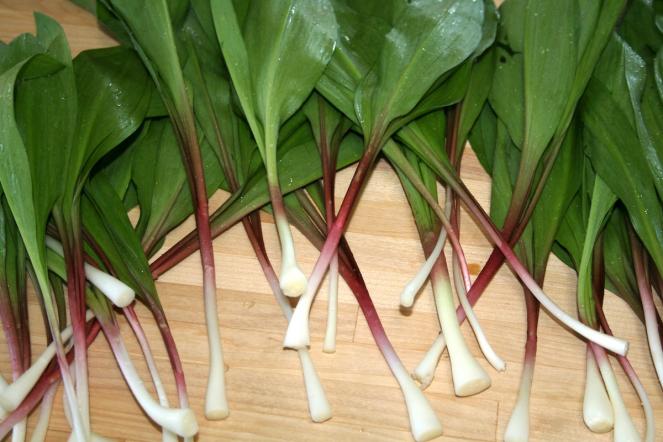 Ramps
Ramps
The undisputed king of spring in my opinion is the ramp or wild leek, which can be found in deciduous woods in rich moist soil. Every part of the ramp can be eaten and tastes like an onion infused with garlic. Many years ago I was trout fishing and walked through an area that smelled like a garlic and onion farm, and it turned out that there were ramps everywhere. I love ramps and spend most of my free time in the early spring gathering them. I pickle them and grill them and make a magnificent ramp and nettle chimichurri that tops a grilled deer heart better than anything else. In my opinion, ramps are the best tasting thing out in the woods.
A couple of years ago, one of my recipes for ramps was included in a cookbook all about ramps: Ramps: Cooking with the Best Kept Secret of the Appalachian Trail. The original recipe was for a shaved asparagus and ramp salad, and this is a variation of that same salad.
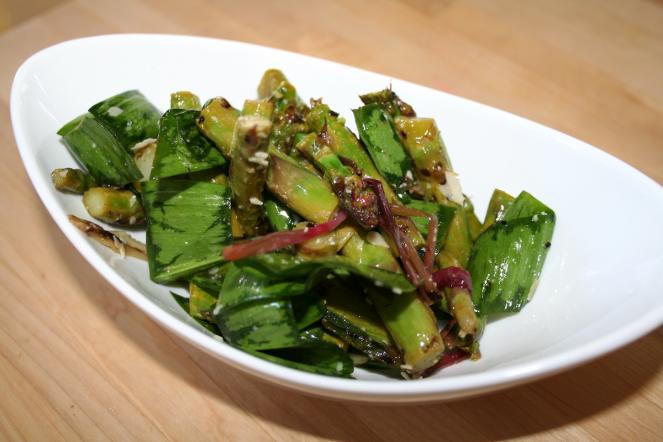 Grilled asparagus and ramp salad
Grilled asparagus and ramp salad
Grilled Asparagus and Ramp Salad
Serves 6
Ingredients
- One pound asparagus
- ½ pound ramps
- ¼ cup lemon juice
- ¼ cup olive oil
- 1/4 cup parmesan cheese
- Salt and pepper to taste
Instructions
- Mix the lemon juice and olive oil together and season with salt and pepper.
- Leave the asparagus whole and cut the ramps just above the pink where the leaf starts to get wide.
- Marinade the asparagus and lower half of the ramps in the lemon juice mixture for at least 30 minutes
- Grill the asparagus and ramps until just tender about 3-5 minutes, reserving the marinade for later
- Allow the asparagus to cool to room temp and then cut the asparagus into bite sized pieces.
- Cut the leaves of the ramps into one inch thick pieces and toss together with the white part of the ramps, the asparagus and parmesan.
- Add the marinade back into the salad and toss, season with salt and pepper as needed.

Jamie Carlson lives in Burnsville, MN with his wife, Amanda, and their two kids Eleanor and Charlie. He works as an Rn at the Minneapolis VA hospital. He enjoys hunting, fishing, foraging, and, of course, cooking. He believes that all food can be tasty if it is prepared with care, and he writes about his adventures cooking everything from Pickled Venison Heart to Roasted Dove on his food blog, You Have to Cook it Right. Follow him at @youcookitright. His last post for SGT was Wild Game Charcuterie.

